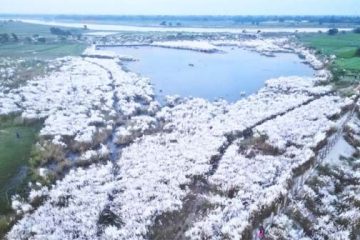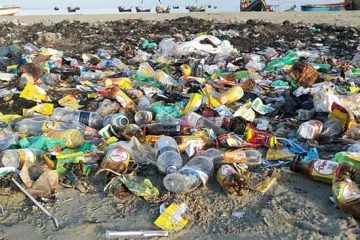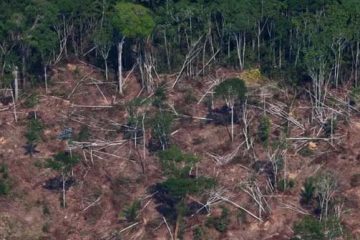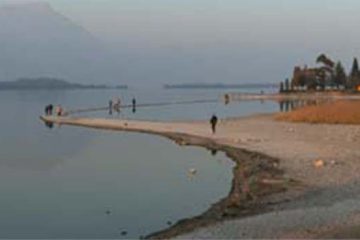Shipbreaking in South Asia
Impact on environment and health
Md. Abu Sayed
 Shipbreaking, referred to as ship recycling, is a type of ship disposal involving the dismantling of an obsolete vessel’s structure for scrapping or disposal. It includes a wide range of activities, from removing all gears and equipment to cutting down the ship’s infrastructure.
Shipbreaking, referred to as ship recycling, is a type of ship disposal involving the dismantling of an obsolete vessel’s structure for scrapping or disposal. It includes a wide range of activities, from removing all gears and equipment to cutting down the ship’s infrastructure.
Every year, about 600 end-of-life ships containing large amounts of toxic and hazardous substances and materials, and fuels, are sent to the beaches of South Asia, where they are dismantled. According to recent figures, 96 per cent of world’s GT ships were dismantled in India, Bangladesh, China and Pakistan. Since 2004, more than 80 per cent of end-of-life vessels of 500 GT and above have been scrapped on tidal beaches in South Asia.
Ships, in particular those built before 1980, contain large amounts of toxic and hazardous substances and materials which may cause death or illness to human beings and produce long term adverse effects on the natural environment. Some of the Hazardous exposure associated with shipbreaking are-
Asbestos: Asbestos is a highly toxic substance that has been banned or strictly restricted for health or environmental reasons by a number of states. At shipbreaking yards in South Asia, workers often remove insulating materials containing asbestos with their bare hands. Prolonged exposure to asbestos dusts and fibres may lead to slow-progressing but fatal diseases, which include asbestosis, lung cancer and mesothelioma. These diseases may not become apparent until many years after exposure to asbestos. Facility must ensure that workers are not exposed to airborne asbestos concentrations in excess of the Permissible Exposure Limit (PEL). The PEL of asbestos is 0.1 fibre per cubic centimeter (f/cc) of air averaged over an eight hour work shift.
Polychlorinated biphenyls (PCBs): These are persistent organic pollutants that were widely used in the ship industry for their insulating properties. They persist in the environment for long periods, gradually accumulate in the fatty tissue of living organisms, and can cause cancer, birth defects and reproductive and neurological damage. When heated, PCBs release dioxin and furan, two toxic chemicals which are unintentional by-products of most forms of combustion and are known to be carcinogens. PEL of PCB is 1.0 mg/m3 of workplace air over an 8-hour work shift.
Polyvinyl chloride (PVC): Lots of equipment and materials on ships are made of PVC. PVC products pose serious threat to human health and the environment at every stage of their existence. PVC waste introduces hazardous chemicals into groundwater when buried, and releases dioxin emissions and carbon monoxide into the air when burned. PVC has been known to cause several serious diseases, including cancer and kidney damage, and may interfere with the reproductive and neurological systems.
Heavy metals: Lead, mercury, arsenic or cadmium may be found in paints, coatings and electrical equipment. These parts are often dumped or burnt on the beaches where ships are dismantled, adversely affecting both human health and the environment. Heavy metals build up inside living organisms, and may lead to severe long-term effects, including cancer and damage to the nervous, digestive, reproductive and respiratory systems. Permissible Exposure Limit are-Lead (Pb) 30µg/m3 of air, averaged over an 8 hour period, Mercury (Hg) 0.1 mg/m3, Arsenic (As) no more than 10 µg /m3 and Cadmium (Cd) 2.5µg/m3.
Polycyclic aromatic hydrocarbons (PAHs): The health hazard from PAHs comes from directly inhaling fumes during torch cutting, smouldering of paints and burning of waste. Long-term exposure to PAHs may cause malignant tumours. At work place, PEL of PAHs is 0.2 mg/m3.
Organotins: The most widely-used organotin, Tributyltin (TBT), has been used in anti-fouling paints, and is considered as one of the most toxic compounds for aquatic ecosystems. Organotin compounds can damage human health even in small doses. In South Asian shipbreaking yards, workers usually remove TBT containing paints with no skin, eye or lung protections, which are mandatory in several countries in order to protect workers from exposure to organotin compounds. PEL of Tributyltin (TBT) is 0.1 mg/m3.
Oil and sludge: Oil residues and sludge are spilled and mixed with soil and water on the beach, poisoning marine organisms and other forms of life (birds, fish, plants, etc.). The primary danger to workers handling oil and fuel on ship is that of fire and explosion. Other exposure routes for the hazardous components in oils and fuels are inhalation and consumption of contaminated fish and water, which also threaten communities living in proximity of the yards.
Bilge water: It is usually heavily contaminated with oil and cargo residues, in addition to other pollutants (such as inorganic salts and heavy metals). During dismantling activities, bilge water is often released to the environment directly or by lack of containment during transfer operations. When released into the environment, it may cause widespread pollution of water and coastal areas, and adversely affect human beings through the consumption of contaminated water and fish.
Ballast water: It may contain pollutants, such as residual fuel, cargo hold residues, oil and grease, hydrocarbons and heavy metals. In addition to the pollution of water and coastal areas caused by the contaminants contained in it, the discharge of ballast water may cause the introduction of alien species which threaten the ecological balance of the surrounding sea and thereby represent a direct threat to biodiversity. Ballast water can also carry viruses and bacteria that may cause epidemics.
Freon: Commonly found in refrigeration systems this, if released, could evaporate rapidly to create atmosphere immediately dangerous to life or health.
Halon and carbon dioxide: Used in fire suppression systems, if released into spaces, these can create atmosphere immediately dangerous to life or health.
Fire: It may be originated from ignited insulation, matting, lagging, and residual fuel; and from lubricants and other flammable liquids.
Excess noise: Noise is associated with grinding, hammering, metal cutting, and other activities. Elevated noise level can cause hearing impairment, hypertension, ischemic heart disease, annoyance and sleep disturbance. At work place the PEL of noise is 90 dB(A) over an 8 hour workday.
In many shipbreaking yards in south Asia, workers are not provided with personal protective equipment (PPE), such as skin, eye or lung protection. Appropriate PPE for working in specialized areas, such as respiratory protective equipment for work in conditions where there is a risk of oxygen deficiency, is also generally not available. There is usually no equipment for machine safety, fire safety, chemical safety and water safety, and when such equipment exist, these poorly maintained. With a few exceptions, the vast majority of workers do not receive any information on the hazards or risks to health and safety, nor do they receive any training on how to minimise risks to health and safety at work.
According to media reports, more than 400 workers were killed and 6,000 seriously injured between 1985 and 2005 in Bangladesh, but NGOs estimate that at least 1,000 people have died in Chittagong due to accidents over the last decades. According to official figures, there were 434 incidents at the Alang shipbreaking yard(India) between 1996 and 2003, killing 209 workers. A medical study submitted to the Indian Supreme Court in 2006 concluded that 16 per cent of the workforce handling asbestos in Alang showed symptoms of asbestosis, and was therefore at serious risk of developing mesothelioma in future.
Improper storage and disposal of scrap metal and waste contaminate the soil and groundwater resources, causing acute and long-term pollution. In addition, the release of ozone-depleting gases from cooling systems contributes to worldwide climate change problems.
Most of the shipbreaking yards of South Asian countries do not have any containment to prevent pollution of soil, air, marine and freshwater resources, nor the technology needed to ensure the environmentally safe management and disposal of hazardous waste and materials.
Little work has been carried out to assess the environmental impact of shipbreaking. A study commissioned by the Gujarat Maritime Board in 2005 only found “low” to “moderate” levels of hazardous substances in soil and sediment samples. However, other studies carried out at various shipbreaking yards found high levels of contamination of coastal soil, seawater and drinking water sources, negatively affecting the marine ecosystem and the livelihood of local communities. A recent report published by the United Nations Environment Programme(UNEP) included shipbreaking industries in India, Bangladesh and Pakistan among the major land-based sources of marine pollution in the South Asian Seas region.
The writer is an agriculturalist and environmentalist. Email: asayedmas@yahoo.com





